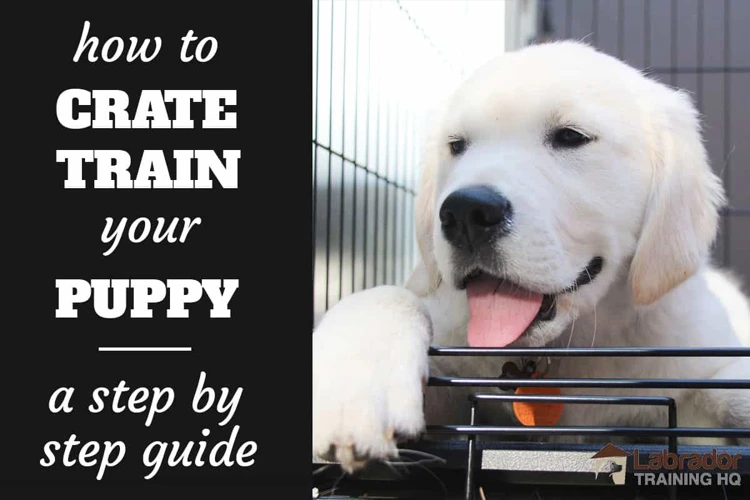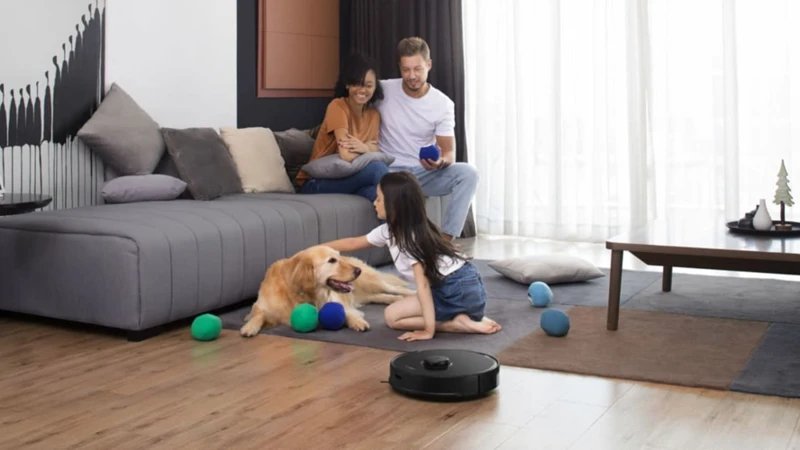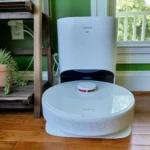We all love our furry companions, but the one thing we don’t love is the never-ending struggle to keep our floors clean. Fortunately, smart vacuum cleaners can make our lives easier by taking care of the mess for us. However, many pets may find these devices intimidating or even terrifying. So, what can we do to help our furry friends feel comfortable around smart vacuum cleaners? In this article, we’ll explore three effective methods for training your pet to be comfortable with a smart vacuum cleaner. Whether you have a new puppy or an older fur buddy, these methods will help you make vacuuming a stress-free experience for both you and your pet.
Why Train Your Pet to Be Comfortable with a Smart Vacuum Cleaner?

Introducing a smart vacuum cleaner to your pet can be a challenging task. Pets may find the sound, movement, and overall presence of a smart vacuum cleaner intimidating, triggering fear or anxiety. However, training your pet to feel comfortable with a smart vacuum cleaner has significant benefits for you and your furry companion. Not only will it save you time and effort, but it will also make your home cleaner and healthier.
One of the biggest benefits of training your pet to be comfortable with a smart vacuum cleaner is that it can help reduce their stress levels. By getting them used to the presence of a smart vacuum cleaner, they can learn that there is nothing to fear. This can be particularly beneficial for pets that have a history of anxiety or fear, as it can help them feel calmer and more relaxed.
Another benefit is that it can help reduce the chance of accidents. Pets that are unfamiliar with a smart vacuum cleaner may try to attack it, bite it, or knock it over, leading to potential injury or damage to the machine. By training your pet to be comfortable around the vacuum cleaner, you can prevent any potential mishaps from occurring.
Training your pet to be comfortable with a smart vacuum cleaner can save you time and effort. Rather than having to lock your pet up in a separate room or waiting until they are outside, your pet can be present while you clean. This means you can spend more time with your pet while still maintaining a clean home.
Incorporating your pet into the cleaning process can also be a fun bonding experience for both you and your pet. It can also serve as a source of mental stimulation, particularly for pets that are smart and active.
Training your pet to be comfortable with a smart vacuum cleaner can be a rewarding process. By following the appropriate methods, such as the slow and steady approach, positive association training, and desensitization training, you can successfully train your pet to accept the presence of a smart vacuum cleaner. To learn more tips for pet training with smart vacuums, check out our related articles: 5 Tips for Pet Training with Smart Vacuums, and Scared Pet with Smart Vacuum? Here’s How to Help.
Method 1: Slow and Steady Approach

Are you worried about how your pet will react to a smart vacuum cleaner? If so, Method 1: A Slow and Steady Approach may be the best method for you. This method involves gradually introducing your pet to the vacuum cleaner and rewarding positive behavior. It’s important to take your time and not rush the process to prevent any negative associations with the vacuum cleaner. If you’re interested in learning more about other methods of training your pet to be comfortable with a smart vacuum, check out our articles on smart vacuum pet training, keeping your pet calm during vacuum cleaning, and common mistakes to avoid.
Step 1: Introduce Your Pet to the Vacuum Cleaner
Before you can train your pet to be comfortable with a smart vacuum cleaner, you’ll need to introduce them to the device. Here are some simple steps to follow:
Step 1: Start by bringing the vacuum cleaner into the room where your pet is located, but keep it turned off. Allow your pet to sniff and investigate the device. This will help them become familiar with it and understand that it’s not a threat.
Step 2: If your pet seems nervous or anxious around the vacuum cleaner, don’t force them to interact with it. Give them time to adjust to its presence and approach it at their own pace. You can also try placing treats near the vacuum cleaner to encourage them to come closer.
Step 3: Once your pet is comfortable being near the vacuum cleaner, you can try turning it on briefly. It’s important to start with short intervals of no more than 5 seconds at a time. This will help your pet get used to the sound and the movement of the vacuum cleaner.
Step 4: If your pet remains calm and relaxed, praise and reward them with treats. However, if your pet seems nervous or fearful, turn off the vacuum cleaner immediately and try again later.
By following these simple steps, you can help your pet feel more comfortable around the smart vacuum cleaner. Remember, every pet is different, so be patient and allow them to progress at their own pace. With consistent training and positive reinforcement, your pet may even learn to enjoy the presence of the vacuum cleaner.
Step 2: Turn the Vacuum Cleaner On
Now that your pet has been comfortably introduced to the vacuum cleaner, it’s time to turn it on. This step may be a little overwhelming for your furry friend, but with a calm approach, you can help them become comfortable with the sound and movement of the machine.
Step 2: Turning on the vacuum cleaner
- Start by turning on the vacuum cleaner in another room, so your pet can hear the sound from a distance.
- Let your pet listen to the sound for a few minutes while you keep them distracted with toys or treats.
- If your pet seems calm, you can turn off the machine and move a little closer while turning it back on.
- Keep repeating this process, gradually moving closer to your pet each time you turn on the vacuum cleaner.
- Remember to keep treats and toys on hand to keep your pet calm and happy during this process.
This step is essential in helping your pet become more comfortable around the vacuum cleaner. Don’t rush the process, and take as much time as needed to ensure that your furry friend is relaxed and calm. With persistence and patience, you’ll be able to get to the point where your pet won’t even flinch when the vacuum cleaner is turned on.
Step 3: Reward Your Pet
During this step, it’s important to reward your pet for their positive behavior around the vacuum cleaner. This will help them associate the vacuum cleaner with a positive experience and encourage them to feel more comfortable around it.
Here are some suggestions for rewards to give your pet during this step:
| Reward | Explanation |
|---|---|
| Treats | High-value treats like small pieces of cooked chicken, cheese or liver treats can be used to reward positive behavior. Make sure to only give treats when your pet is behaving positively around the vacuum cleaner, and not when they are fearful or anxious. |
| Toys | Offering your pet a favorite toy to play with after a successful training session can also be a good reward. This can help distract them from the vacuum cleaner and associate the experience with a positive outcome. |
| Praise | Giving your pet verbal praise and petting can also be effective in positively reinforcing their behavior. Use a high-pitched, happy voice to show your pet that you are pleased with their progress. |
It’s important to note that rewards should only be given when your pet is exhibiting positive behavior around the vacuum cleaner. If your pet is showing signs of fear or anxiety, it’s important to stop the training session and try again later. Additionally, it’s important to be consistent with rewarding your pet to ensure that they continue to associate the vacuum cleaner with positive experiences.
Step 4: Gradually Increase Vacuum Cleaner Usage
Now that your pet is comfortable being around a turned-on smart vacuum cleaner, it’s time to increase their exposure gradually. Here are some steps to help you do this:
- Step 1: Turn on the smart vacuum cleaner and let it run for a few seconds while your pet is in the room. Observe their behavior and body language.
- Step 2: If there is no sign of stress or fear, turn off the vacuum cleaner and reward your pet with treats and praise.
- Step 3: Repeat this process, gradually increasing the amount of time that the smart vacuum cleaner is turned on.
- Step 4: If your pet starts showing any signs of discomfort or stress, reduce the amount of time that the vacuum cleaner is in use and repeat the previous step until they are comfortable again.
- Step 5: As your pet becomes more comfortable, gradually increase the frequency of using the smart vacuum cleaner. Start by using it once a week, then increase it to twice a week, and so on.
- Step 6: Continue to monitor your pet’s behavior and adjust the training accordingly. Remember to always use positive reinforcement and offer treats and praise for good behavior.
Remember, every pet is unique and will require their own time to adjust to the presence of a smart vacuum cleaner. It’s important to be patient and not rush the process. By following these steps and being consistent with your training, you can help your furry friend feel comfortable and at ease in the presence of a smart vacuum cleaner.
Method 2: Positive Association Training

Now that we’ve covered the slow and steady approach in method 1, let’s explore method 2: positive association training. This method relies on creating a positive association between your pet and the vacuum cleaner by using treats and praise. By taking a gentle and rewarding approach, you can help your furry friend change their negative perception of the vacuum cleaner into a positive one. Keep reading to learn the step-by-step process for implementing this training method.
Step 1: Introduce Your Pet to the Vacuum Cleaner
One of the first steps in training your pet to feel comfortable around a smart vacuum cleaner is to introduce them to the device in a safe and controlled manner. Here’s how to do it:
| Step 1 | Bring your pet into the room where the vacuum cleaner is located. |
| Step 2 | Allow your pet to sniff and investigate the vacuum cleaner at their own pace. |
| Step 3 | If your pet shows signs of fear or discomfort, reassure them by speaking in a calm tone and providing comfort through petting or giving treats. |
| Step 4 | Repeat the process multiple times until your pet becomes familiar with the vacuum cleaner and is not showing any signs of fear or discomfort. |
It’s important to note that every pet is different and some may take longer to adjust than others. Be patient and don’t rush the process. The goal is to help your pet feel comfortable and safe around the vacuum cleaner, so they don’t become anxious or stressed when it’s in use.
Step 2: Reward Your Pet
During the training process, it is crucial to reward your pet for positive behavior. This reinforces the desired action and encourages them to repeat it in the future. When introducing your pet to the vacuum cleaner, it is important to make sure they feel safe and comfortable. Here are some ways to reward your pet during the training process:
- Verbal praise: Dogs and cats respond well to positive reinforcement. Giving your pet verbal praise, such as saying “good boy” or “good girl,” can be an effective way to reward them for calm behavior.
- Treats: Using high-value treats, such as small pieces of chicken or cheese, can also be an effective way to reward your pet during the training process. This reinforces positive behavior and helps your pet associate the vacuum cleaner with positive experiences.
- Playtime: If your pet is responding well to the training, take some time to play with them. This can be an opportunity for them to relax and have fun after a successful training session.
- Cuddles: Pets crave affection and attention. After a successful training session, spend some time cuddling and petting your pet. This reinforces positive behavior and helps them feel safe and loved.
Remember, it’s important to be consistent with rewards during the training process. This gives your pet a clear understanding of what actions you want them to take. With patience and persistence, your pet can become comfortable with the vacuum cleaner and feel safe and secure in their home environment.
Step 3: Repeat Process with Vacuum Cleaner Turned On
Now that your pet is becoming comfortable with the vacuum cleaner, it’s time to move on to the next step. In this step, you will repeat the previous process, but this time with the vacuum cleaner turned on.
Step 3: Repeat Process with Vacuum Cleaner Turned On
1. Start with the vacuum cleaner turned off, just like in the previous step.
2. Introduce your pet to the turned-on vacuum cleaner from a distance. If they seem frightened or unsure, try turning the vacuum cleaner off again and gradually approaching them.
3. Use high-value treats to reward your pet for showing positive behavior and remaining calm. Remember, positive reinforcement is key to successful training.
4. Gradually move closer to your pet with the vacuum cleaner turned on. Reward them for comfortable behavior, such as sitting or lying down calmly.
5. If at any point your pet becomes frightened or anxious, stop and try again later. It’s important not to push them too far too fast.
6. As with the previous step, repeat this process multiple times, gradually increasing the amount of time your pet spends around the turned-on vacuum cleaner.
It’s normal for your pet to be nervous around the vacuum cleaner at first, but with patience and consistency, they can learn to feel comfortable with it. Remember to always use positive reinforcement and to never force your pet to do something they’re uncomfortable with.
Step 4: Gradually Move Closer to Active Vacuum Cleaner
At this point in the positive association training process, your pet should have developed a positive connection with the sight and sound of the vacuum cleaner. Now it’s time to take things a step further. You should gradually move your pet closer to the active vacuum cleaner while it is turned on.
This should be done slowly and gradually. You don’t want to stress your furry friend out and undo any progress you’ve made so far. Begin by placing your pet on the opposite side of the room from where the vacuum cleaner is in use. Use treats and praise to lure them closer towards the vacuum cleaner.
Once your pet is comfortable being in the same room as the vacuum cleaner, start closing some of the distance between them and the machine. Gradually move them towards the vacuum cleaner, always providing positive reinforcement in the form of treats and kind words.
As your pet becomes more confident and comfortable with being close to the active vacuum cleaner, make sure to keep the machine at a low volume for a while to prevent scaring your pet with any sudden loud noises.
Remember to always keep an eye on your pet’s body language – if they are getting scared or nervous, take a step back and adjust the distance accordingly. It’s important to move at a pace that is comfortable for your pet.
With a little patience and consistency, your pet will eventually be able to be in the same room as the vacuum cleaner while it’s running without any fear or anxiety.
Step 5: Test with Vacuum Cleaner In Use
After following the previous steps in Method 2: Positive Association Training or Method 3: Desensitization Training, it’s time to test your pet’s comfort level with a vacuum cleaner in use. This can be a crucial step in ensuring your pet is fully trained and comfortable with the smart vacuum cleaner in your home.
Carefully set up the testing environment: Before testing your pet, make sure the vacuum cleaner is set up in a safe and secure location. Clear the area of any obstacles or cords that your pet might trip over or get tangled in, and make sure the vacuum cleaner is not too close to any furniture or walls.
Start the vacuum cleaner on low power: Begin by starting the vacuum cleaner on a low power setting. This will help to minimize any loud noises or sudden movements that could startle your pet. Observe your pet’s behavior from a distance and gauge their comfort level.
Gradually increase the power and duration: Over time, gradually increase the power and duration of the vacuum cleaner. Pay close attention to your pet’s behavior and body language throughout the process. If they seem anxious or uncomfortable, stop the vacuum cleaner and revert back to the previous step until they are comfortable again.
Offer treats and positive reinforcement: As your pet becomes more comfortable with the vacuum cleaner in use, offer them high-value treats and positive reinforcement. This will help to reinforce their good behavior and create a positive association between the vacuum cleaner and rewards.
Remember that training your pet to feel comfortable with a smart vacuum cleaner takes time and patience. Each pet will have their own unique personality and behavior, so be flexible in your approach and be willing to adapt to your pet’s needs. With consistent training, positive reinforcement, and lots of patience, your pet can learn to feel comfortable and safe around your smart vacuum cleaner.
Method 3: Desensitization Training

If your pet still seems anxious or frightened around the smart vacuum cleaner, desensitization training may be the key to helping them overcome their fear. This training method involves gradually introducing your pet to the vacuum cleaner and increasing their exposure to it over time until they become more comfortable with its presence. With patience and consistency, desensitization training can be a highly effective way to train your pet to feel comfortable around the smart vacuum cleaner. Let’s dive into the steps involved in this method.
Step 1: Let Your Pet Smell the Vacuum Cleaner
Step 1: Introduce your pet to the vacuum cleaner by allowing them to smell it. This will help your pet become familiar with the device before it is turned on. Follow these simple steps to help your pet feel comfortable:
- Place the vacuum cleaner in the room with your pet.
- Allow your pet to approach the vacuum cleaner at their own pace and sniff it.
- Avoid forcing your pet to smell the vacuum cleaner as this could cause fear or anxiety.
- Use positive reinforcement by offering your pet a treat when they come close to the vacuum cleaner.
It’s important to note that some pets may be wary of unfamiliar objects in general, so it’s important to take some extra time to let them sniff and explore the vacuum cleaner. By allowing your pet to smell the vacuum cleaner in a non-threatening way, you are helping to build trust and reduce any potential anxiety towards the device. This simple first step can go a long way in creating a positive association with the vacuum cleaner in your pet’s mind.
Step 2: Turn the Vacuum Cleaner On
Once your pet is comfortable with the presence of the vacuum cleaner, you can move on to the next step: turning it on. This can be a daunting experience for some pets, as the noise and movement of the vacuum cleaner can be frightening.
To make the experience less overwhelming for your pet, follow these steps:
| Step 1: | Turn the vacuum cleaner on in a separate room while your pet is in a different area. This will allow them to hear the noise from a distance and get used to it gradually. |
| Step 2: | Once your pet seems comfortable with the distant noise, turn on the vacuum cleaner in the same room as your pet, making sure to keep a safe distance. |
| Step 3: | Observe your pet’s behavior closely. If they seem scared, turn off the vacuum cleaner and revert back to the previous step. |
| Step 4: | If your pet seems relaxed, reward them with treats and praise to reinforce positive behavior. |
It is important to note that the vacuum cleaner’s noise can be extremely uncomfortable for some pets, especially those with sensitive hearing. If your pet shows extreme signs of anxiety, it may be best to consult with a veterinarian or professional animal trainer for additional support.
Remember to remain patient and consistent throughout the process, as gradual exposure is key to success. With time and positive reinforcement, your pet can learn to feel comfortable with a smart vacuum cleaner and even see it as a non-threatening part of their daily environment.
Step 3: Gradually Introduce Your Pet to the Vacuum Cleaner
In the desensitization training method, you want to gradually introduce your pet to the vacuum cleaner. This approach involves slowly exposing your pet to the vacuum cleaner and allowing them to approach it at their own pace.
To implement this step, follow these tips:
1. Keep the Vacuum Cleaner at a Distance: Start by placing the vacuum cleaner in a corner of the room, away from your pet. This will allow your pet to see the vacuum cleaner and become accustomed to its presence.
2. Encourage Your Pet: Using positive reinforcements such as treats, toys or praise, encourage your pet to approach the vacuum cleaner. If they are hesitant, keep the vacuum cleaner in place and continue to encourage them.
3. Incorporate Short Sessions: Gradually increase the time your pet spends around the vacuum cleaner in short increments until they feel more comfortable with it. For example, start with just a few minutes a day and gradually increase by five minutes each day until your pet can be in the same room with the vacuum cleaner without becoming anxious.
4. Stay Calm: Your pet is highly attuned to your emotions, so if you are anxious or tense around the vacuum cleaner, your pet may become anxious as well. Stay calm and relaxed to help your pet feel more comfortable.
By gradually introducing your pet to the vacuum cleaner and allowing them to approach it at their own pace, you can help them feel more comfortable and less stressed the next time you need to use it. Remember to be patient, consistent, and use positive reinforcement to make the training experience enjoyable for your pet.
Step 4: Repeat Process with Vacuum Cleaner In Use
Once your pet is comfortable with the sound of the turned-on vacuum cleaner, it’s time to repeat the process with the vacuum cleaner in use.
Here are the steps to follow:
- Start by turning on the vacuum cleaner in the same room as your pet.
- Observe your pet’s reaction from a distance. If he seems comfortable, move a little closer to the vacuum cleaner. If he looks anxious, move further away.
- If your pet remains calm, move even closer to the vacuum cleaner and continue to offer him rewards and praise.
- If your pet looks uneasy, move away from the vacuum cleaner and try again later or the next day. Repeat the process until your pet is comfortable with the vacuum cleaner in use.
Remember, every pet is different, and some may take longer to feel comfortable than others. It’s crucial to be patient and consistent in your training approach.
Keep offering your pet high-value treats and praise as he becomes more comfortable with the vacuum cleaner in use. Over time, your pet will learn that the vacuum cleaner is not a threat and that he can remain calm while it’s in operation.
Training your pet to be comfortable with a smart vacuum cleaner takes time and patience, but it’s worth the effort. By following these training methods, you can help your furry friend feel more relaxed around household cleaning appliances, making life easier for both of you.
Step 5: Gradually Increase Exposure Time
As your pet is becoming more and more comfortable with the vacuum cleaner, it’s time to gradually increase the exposure time. This step is crucial to help your pet get used to the sound and movement of the vacuum cleaner for longer periods of time. Here’s how to do it effectively:
- Start small: Begin with short, five-minute vacuuming sessions, so your pet doesn’t get overwhelmed. Gradually increase the time of your vacuuming sessions when your pet is ready to handle it.
- Observe your pet’s behavior: While vacuuming, pay attention to your pet’s body language. If it looks frightened or anxious, it might be necessary to go back to shorter sessions for a little longer until it feels comfortable again.
- Stay in sight: As you increase exposure time, be sure to stay within eyesight of your pet. This helps your pet feel safe and secure. Call your pet over to you for a treat or cuddles during vacuuming breaks.
- Play calming sounds or music: Sometimes, playing soft, calming music or sounds can help your pet relax during vacuuming sessions.
- Keep reinforcing positive behavior: As always, positively reinforce your pet’s good behavior with treats and praise. Let your pet know it’s doing a great job getting used to the vacuum cleaner.
- Gradual progress: Gradually increasing the exposure time will allow your pet to slowly adjust to the vacuum cleaner. Over time it should be able to tolerate the noise and movement without feeling stressed, and eventually, it may even ignore the vacuum cleaner altogether.
Remember, this step of gradually increasing exposure time should be done at your pet’s pace. It’s important to be patient and consistent throughout the process. By using the right techniques and giving your pet plenty of love and reinforcement, you can train your pet to be comfortable with the smart vacuum cleaner.
Tips for Successful Training
As you work towards helping your pet feel comfortable with a smart vacuum cleaner, there are few things you can do to increase your chances of success. These tips can make a significant difference in how your furry friend responds to the training. By incorporating these suggestions into your training, you can help your pet feel at ease around the vacuum and foster a positive experience. Let’s explore some of these tips in more detail below.
Tip 1: Start Training at an Early Age
Starting training at an early age is essential when it comes to acclimatizing your pet to a smart vacuum cleaner. By “early age,” we mean 12 weeks or younger. At this time, your pet is still in the socialization stage, where they are most receptive to new experiences and less likely to develop phobias or anxieties.
Training an adult pet that has never been exposed to a vacuum cleaner can be more challenging and may take a longer period of time compared to starting with a puppy or kitten.
To emphasize the importance of starting training early, consider the table below:
| Age Range | Training Difficulty | Training Duration |
|---|---|---|
| 12 weeks and below | Easy | Short |
| 12 weeks to 6 months | Moderate | Moderate |
| 6 months and above | Challenging | Long |
As you can see, the earlier you start, the easier and shorter the training process will be. It is also worth noting that puppies and kittens are generally more adaptable and open to new experiences, making them easier to train compared to adult pets.
We highly recommend starting the training process as soon as possible to ensure that your pet becomes comfortable with a smart vacuum cleaner. The sooner your pet gets used to the machine, the less stressful vacuuming will be for them and for yourself.
Tip 2: Use High-Value Treats
When it comes to training your pet to feel comfortable with a smart vacuum cleaner, nothing works better than positive reinforcement. And what better way to reinforce good behaviour than with treats? But not just any treat would do the trick. You need to use high-value treats – the kind that your furry friend can’t get enough of. Here are some options that you can consider:
- Cooked Meat: Most pets love chicken, turkey, and beef. Cut them into small, bite-sized pieces and use them as treats.
- Cheese: Cheese is another treat that most pets can’t resist. Just make sure that your pet is not lactose intolerant before you start feeding them cheese.
- Fruits: Some pets have a sweet tooth too. Fruits like bananas, apples, and strawberries can be a healthy and tasty treat for them.
- Commercial Treats: If you don’t have the time to prepare homemade treats, you can always buy commercially available ones. Just make sure that they are made of high-quality ingredients and don’t contain any harmful additives.
The key here is to find what works best for your pet. It may take some experimentation to find the perfect treat that your fur baby can’t resist. Once you have found the right treat, use it as a reward for good behaviour during the vacuum cleaner training sessions. Your pet will quickly learn to associate positive experiences with the vacuum cleaner, making the training process much more manageable. Just remember to give treats in moderation and adjust your pet’s diet accordingly to prevent overfeeding.
Tip 3: Be Patient and Consistent
It’s of utmost importance to remain patient and consistent while training your pet to feel comfortable with a smart vacuum cleaner. Keep in mind that not all pets are the same, and some may need more time to adjust than others.
Here are a few ways to stay patient and consistent during the training process:
| Tip | Explanation |
|---|---|
| Take it Slow | Remember to go at a pace that your pet is comfortable with, and do not rush the process. |
| Stick to a Routine | Try to train your pet at the same time each day to create a routine and consistency. |
| Positive Reinforcement | Use rewards consistently, such as high-value treats, to encourage good behavior and create positive reinforcement. |
| Be Patient | It may take some time for your pet to adjust to the vacuum cleaner, so be patient and avoid getting frustrated if they do not immediately respond as you hope. |
| Stay Calm | Your pet will be able to sense if you’re anxious or nervous, so remain calm and relaxed throughout the training process. |
| Consistency is Key | Stay committed to the training process, and avoid skipping training sessions, as inconsistency can set back progress. |
By following these tips and remaining patient and consistent throughout the training process, you can help ensure that your pet feels comfortable with a smart vacuum cleaner and reduce any potential stress or anxiety they may experience.
Conclusion
In conclusion, training your pet to feel comfortable with a smart vacuum cleaner may take some time and effort, but it is definitely worth it in the long run. By using one or more of the methods outlined in this article, you can help your furry friend overcome their fear or uncertainty around the vacuum cleaner and create a positive association that can lead to a less stressful and more harmonious household.
Remember to approach the training process with patience and consistency, and to use high-value treats and rewards to reinforce positive behaviors. It’s also important to start training at an early age and to gradually increase exposure to the vacuum cleaner over time.
Whether you utilize the slow and steady approach, positive association training, or desensitization training, be sure to adapt the method to your pet’s individual needs and personality. With the right techniques and plenty of perseverance, you can help your pet feel comfortable and at ease with the smart vacuum cleaner, making household cleanup a breeze for all involved.
Frequently Asked Questions
1. Can my pet see the smart vacuum cleaner as a threat?
Yes, pets can perceive the vacuum cleaner as a threat due to its loud noise or sudden movements. However, with proper training, your pet can learn to feel comfortable around the vacuum cleaner.
2. What type of treats should I use during training?
High-value treats such as cooked chicken, hot dogs, or cheese work well as training rewards. Use treats that your pet loves and will be motivated to work for.
3. When should I start training my pet to feel comfortable with the vacuum cleaner?
The earlier you start training your pet, the better. Ideally, you should start training when your pet is a puppy or kitten. However, it is never too late to start training as long as you are patient and consistent.
4. What if my pet gets scared or anxious during training?
If your pet becomes scared or anxious during training, stop the training session and try again later. Do not force your pet to continue training if they are uncomfortable. It is important to take things slow and gradually build up your pet’s confidence.
5. How often should I train my pet to feel comfortable with the vacuum cleaner?
You should train your pet for short sessions every day or every other day to help them feel comfortable around the vacuum cleaner. Consistency is key when it comes to training.
6. Can I use a traditional vacuum cleaner for training?
Yes, you can use a traditional vacuum cleaner for training. However, a smart vacuum cleaner may be less intimidating due to its quieter operation and ability to avoid obstacles.
7. Should I punish my pet if they do not cooperate during training?
No, you should never punish your pet during training. Positive reinforcement is the most effective way to train your pet and build a strong bond of trust and respect.
8. How soon can I expect to see progress during training?
It depends on your pet’s personality and past experiences with the vacuum cleaner. Some pets may take longer to feel comfortable while others may make progress quickly. Be patient and celebrate every small success your pet makes.
9. Can I hire a professional trainer to help with the training process?
Yes, you can hire a professional trainer to help you with the training process if you are struggling or do not feel confident in your abilities. A professional trainer can provide guidance and support to help you and your pet succeed.
10. Is it safe for my pet to be in the same room as the vacuum cleaner?
As long as your pet is comfortable and feels safe, it is generally safe for them to be in the same room as the vacuum cleaner. However, be sure to supervise your pet and keep the vacuum cleaner away from them during use to avoid any accidents or injuries.








